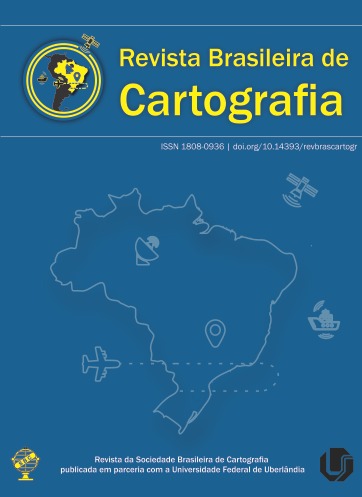Evaluation of the New Transformation Parameters between ITRF (IGS) and SIRGAS2000 at IBGE-PPP with Time Series Analysis
Main Article Content
Abstract
The IBGE-PPP, online Precise Point Positioning (PPP) service, estimates coordinates originally referenced to the materializations of the ITRF (IGS) and then make them compatible for SIRGAS2000 with the application of the Helmert transformation and its respective transformation parameters. On May 17, 2020, IBGE-PPP started using a new set of parameters (P2), discontinuing the old set (P1). In this context, this work aims to assess the impacts of the new parameters on the compatibility of references and update of coordinates used by IBGE-PPP, based on the analysis of time series of data from two stations of RBMC, NAUS, and AMCO. Analyzing the time series SIRGAS2000 compatible with P1 (SCP1) and P2 (SCP2) for the two stations, it was observed that the series of north components (Δn) SCP1 showed level changes (differences) of approximately ± 0.017 m and –0.013 m in relation to SCP2, in the periods referring to the materializations of ITRF2005 (IGS05) and ITRF2014 (IGS14). The series of este (Δe) and vertical (Δu) SCP1 components also showed differences when compared to SCP2, but with magnitudes between 0.001 m and 0.006 m and 0.004 m and 0.012 m, respectively. Considering the sets of transformation parameters between the ITRF (IGS) and SIRGAS2000 materializations, it was observed that the SCP2 series showed more consistent results when compared to the SCP1 series, reducing the impacts caused by the exchange of references that occurred over time. In addition, the SCP2 series were compatible with the series referenced to ITRF2014 (IGS) at a level less than or equal to 0.002 m.
Downloads
Metrics
Article Details
Authors who publish in this journal agree to the following terms:
- Authors retain copyright and grant the journal right of first publication with the work simultaneously licensed under a Creative Commons Attribution License that allows others to share the work with an acknowledgment of the work's authorship and initial publication in this journal.
- Authors can enter into separate, additional contractual arrangements for the non-exclusive distribution of the journal's published version of the work (e.g., post it to an institutional repository or publish it in a book), with an acknowledgment of its initial publication in this journal.
- Authors are permitted and encouraged to post their work online (e.g., in institutional repositories or on their website) before and during the submission process, as it can lead to productive exchanges, as well as earlier and greater citation of published work (see "The Effect of Open Access").





